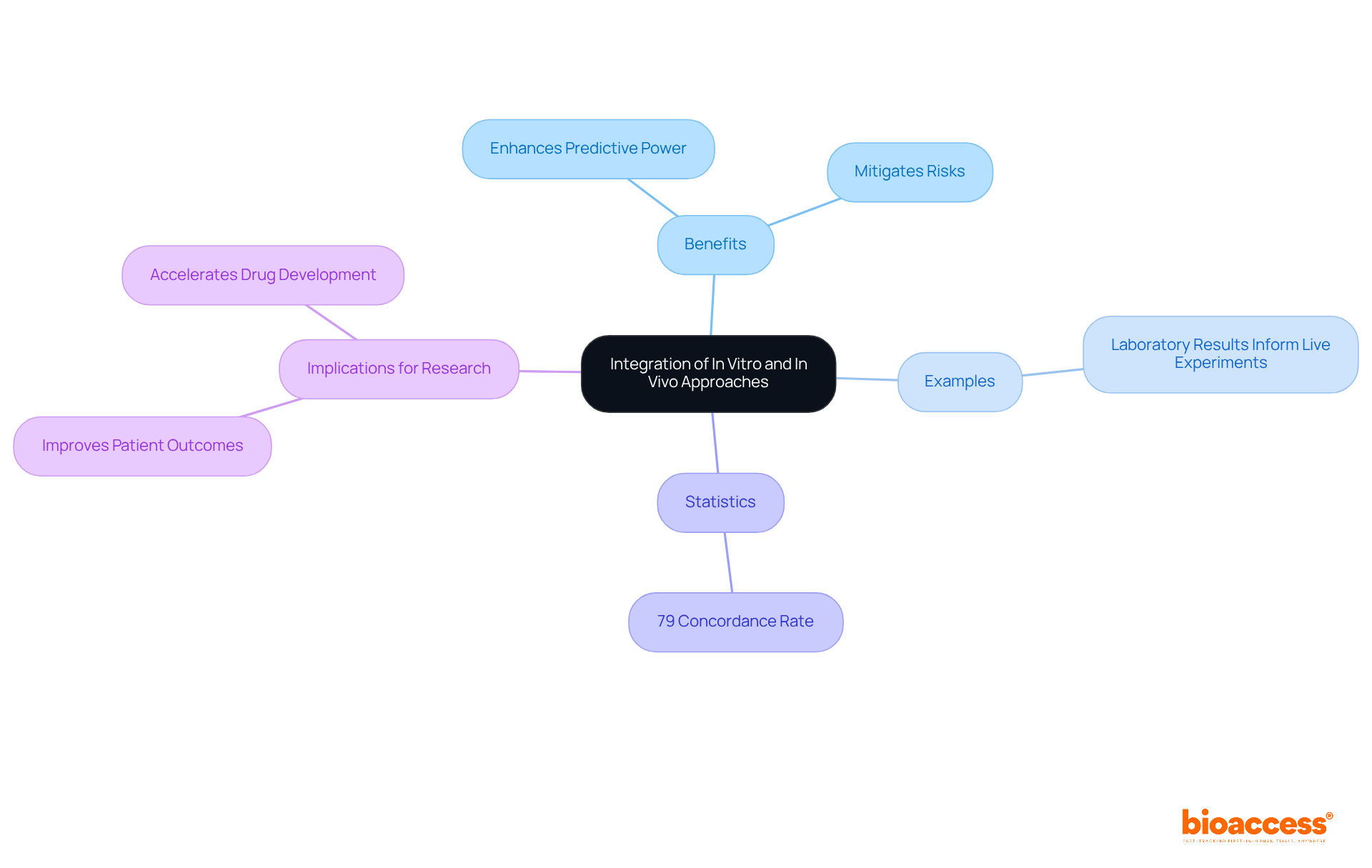


Understanding the distinctions between in vitro and in vivo methodologies is essential for anyone involved in clinical research. These two approaches form the backbone of drug development, each providing unique insights crucial for evaluating the safety and efficacy of new treatments. Researchers often face the challenge of balancing the controlled environment of laboratory studies with the unpredictable nature of living organisms.
How can integrating these methodologies enhance the robustness of clinical findings and ultimately lead to more effective therapies?
The term 'in vitro and invivo meaning' refers to experiments conducted outside of a living organism, typically within controlled laboratory environments like test tubes or petri dishes. This methodology allows researchers to isolate specific variables and analyze cellular processes in detail, making it particularly beneficial for foundational studies in medication development. For instance, laboratory experiments are often employed to evaluate the toxicological impacts of new medications before advancing to clinical trials, aiding in the identification of potential carcinogenic characteristics. In Colombia, the regulatory authority INVIMA oversees the approval and monitoring of in vitro research, ensuring compliance with health standards and safety protocols.
Conversely, in a living context-referring to within the living-includes investigations carried out within living organisms, which can be understood through the in vitro and invivo meaning, encompassing both animal models and human participants. This approach provides critical insights into the physiological relevance of biological interactions and the overall effects of treatments within a complex biological system. Experiments conducted in living organisms are essential for understanding disease mechanisms and assessing the safety and effectiveness of drug candidates, as they reflect real-world biological reactions. INVIMA also plays a vital role in regulating research involving living organisms, ensuring adherence to established guidelines for ethical treatment and safety.
The in vitro and invivo meaning of both methodologies is crucial in clinical research, with laboratory studies often serving as initial steps that guide subsequent live testing. Recent statistics indicate that approximately 30% of pharmaceutical candidates fail in human clinical trials due to negative side effects, underscoring the importance of comprehensive biological assessments following promising laboratory results. Researchers emphasize that utilizing both methodologies enhances the robustness of clinical research, as they complement each other in providing a thorough understanding of interactions and effects. As Jamie Eske notes, "Researchers employ in vivo and laboratory methods to enhance our understanding of illness, disease, and the human body." Looking ahead to 2025, the integration of these approaches remains vital for advancing medical science and developing effective therapies.

The in vitro and in vivo meaning is essential in early-stage medication development, as it enables researchers to assess the effectiveness and safety of various compounds. By utilizing cell cultures, scientists can evaluate how new compounds interact with specific cell types, facilitating high-throughput screening of potential candidates. Conversely, in vivo research is essential for understanding the pharmacokinetics and pharmacodynamics of medications, which is part of the in vitro and in vivo meaning. These studies reveal how drugs behave in the body, covering aspects such as absorption, distribution, metabolism, and excretion.
For instance, animal models are frequently employed to assess the therapeutic effects and safety profiles of new treatments prior to human trials. The research process relies on both methodologies, which include the in vitro and in vivo meaning, to provide complementary data that inform decision-making in drug development. The collaboration between in vitro and in vivo meaning studies not only enhances the understanding of drug interactions but also streamlines the path to effective therapies.

Laboratory experiments play a crucial role in clinical research, offering significant benefits such as cost efficiency, reduced ethical concerns, and the ability to control experimental conditions. These experiments facilitate the rapid screening of multiple compounds, allowing researchers to bypass the complexities associated with living systems. However, it is essential to recognize that in vitro models may not fully replicate the intricate interactions that occur within a whole organism, which can lead to potentially misleading results.
On the other hand, experiments conducted in living environments provide a more comprehensive understanding of biological processes and the effects of therapies in a real-world context. They capture the complexities of drug interactions and systemic responses, offering insights that in vitro studies may overlook. Yet, it is important to consider that in vivo experiments often come with higher costs, increased time demands, and ethical concerns regarding animal usage.
Understanding these factors is vital for researchers as they plan their investigations and analyze outcomes. How do these challenges resonate with your own experiences in clinical research? By comprehending the strengths and limitations of both in vitro and in vivo studies, researchers can make informed decisions that enhance the quality and reliability of their findings.

The integration of laboratory and living organism methodologies is increasingly recognized as vital in clinical research. In vitro experiments lay the groundwork, allowing researchers to pinpoint promising pharmaceutical candidates and assess their mechanisms of action. This initial phase streamlines the medication development process by narrowing down options before advancing to assessments in living organisms, which validate these findings and provide crucial insights into effectiveness and safety. This complementary approach enhances the predictive power of research outcomes and mitigates risks associated with medication development.
For example, laboratory results can inform the design of live experiments, ensuring they are both targeted and relevant. Statistics reveal that combining these methodologies significantly boosts the likelihood of successful clinical outcomes, with studies indicating that integrating in vitro and in vivo approaches can achieve a concordance rate of up to 79% in predicting drug responses. Thought leaders in the field assert that this synergy not only cultivates a deeper understanding of biological phenomena but also accelerates the transition from laboratory discoveries to clinical applications.
In light of these findings, it is imperative for researchers to embrace this collaborative approach, as it holds the potential to transform clinical research and improve patient outcomes.

The exploration of in vitro and in vivo methodologies stands as a cornerstone for advancing clinical research. These approaches offer distinct yet complementary insights into drug development and biological processes, making their understanding crucial for researchers. By grasping the definitions and applications of both methods, scientists can adeptly navigate the complexities of medication development, ensuring that laboratory findings effectively inform subsequent investigations in living organisms.
Key arguments throughout this article underscore the significance of in vitro experiments in isolating variables and assessing initial drug interactions. In contrast, in vivo studies provide a comprehensive perspective on the physiological effects of treatments within living systems. The integration of these methodologies not only enhances the predictive power of research outcomes but also mitigates the risks associated with pharmaceutical development, ultimately paving the way for more effective therapies.
As the landscape of clinical research evolves, embracing the synergy between in vitro and in vivo approaches becomes increasingly vital. Researchers are urged to leverage the strengths of both methodologies to foster innovation and improve patient outcomes. Recognizing the importance of this collaborative framework significantly amplifies the potential for breakthroughs in medical science and therapeutic efficacy.
What do the terms "in vitro" and "in vivo" refer to?
"In vitro" refers to experiments conducted outside of a living organism, typically in controlled laboratory environments like test tubes or petri dishes. "In vivo" refers to investigations carried out within living organisms, which can include both animal models and human participants.
What are the benefits of in vitro research?
In vitro research allows researchers to isolate specific variables and analyze cellular processes in detail. It is particularly beneficial for foundational studies in medication development, such as evaluating the toxicological impacts of new medications before clinical trials.
What role does INVIMA play in in vitro and in vivo research in Colombia?
INVIMA, the regulatory authority in Colombia, oversees the approval and monitoring of in vitro research, ensuring compliance with health standards and safety protocols. It also regulates research involving living organisms to ensure adherence to established guidelines for ethical treatment and safety.
Why is in vivo research important?
In vivo research provides critical insights into the physiological relevance of biological interactions and the overall effects of treatments within a complex biological system. It is essential for understanding disease mechanisms and assessing the safety and effectiveness of drug candidates.
How do in vitro and in vivo methodologies complement each other in clinical research?
In vitro studies often serve as initial steps that guide subsequent in vivo testing. Utilizing both methodologies enhances the robustness of clinical research by providing a thorough understanding of interactions and effects, ultimately aiding in the development of effective therapies.
What are the implications of pharmaceutical candidates failing in human clinical trials?
Approximately 30% of pharmaceutical candidates fail in human clinical trials due to negative side effects, highlighting the importance of comprehensive biological assessments following promising laboratory results.
What is the future outlook for in vitro and in vivo research?
The integration of in vitro and in vivo approaches remains vital for advancing medical science and developing effective therapies, with ongoing emphasis on their combined use in research.